FIRST EVER RODEO IN EASTERN MONTANA
Steffen Ranch – Part 2
April 22, 2020
Who possibly could have resisted this flyer, reproduced exactly as it was written?
"Some of the most astounding Wild West Features ever seen in the state will be exhibited to the public. They will consist of saddle riding, bareback riding, steer riding, etc. These horses are the wildest and most untamable that ever grew hair. If you don't believe it come and seem [sic] them – Cow Boy Running Race, Keg Roping, Potato Race on Horse Back – Big Bowery Dance at Night – Admission 50c ... Fred Dreyer, Manager"
What an extravaganza for only one half-dollar! That's 5 thin dimes or 50 pennies! On 25 July 1922 over 200 folks swarmed onto Bill Steffen's ranch to witness history – the first-ever rodeo in eastern Montana. Participants and riders came from what now are five counties, and the prizes for the lucky or most capable winners were hard, cold cash, no fancy belt buckles back then. Native Americans flocked in, too, for they were eager to try their hands at the wild horse race.
Despite the fact that, by that date, women horse racers and bronc riders, such as Montana's Fannie Sperry, were well-known, the gentle sex did not compete in Mr. Dreyer's production. In fact, it was not lady-like even to stand close to the events, and there was neither a stadium or a grandstand where they could find seats. Sedately, they gathered up on the hill overlooking the site, from which they had a good view and could picnic in the grass with neighbors they rarely saw and watch the little ones frolic.
The feature where women were not only permitted but embraced – literally – was the Bowery Dance, held outside with planks laid to form a floor. Local musicians created the music, and the local bootleggers – don't forget that 1922 had Prohibition - smuggled in their wares. After a little hooch it didn't matter who had won or lost. The important things were tripping over the wood with your pretty lady, drinking a little more than a little, and holding her close as the sun began to rise, when everyone drifted home tired, happy, and, not uncommonly, with a wee headache.
Mr. Dreyer, the impresario, was also a nearby homesteader, who tried his talent as a manager, found he was good at it, and decided that was the business for him. He unloaded his ranch and migrated to California. Rumors held that he made it big out there, but the old-timers with whom we spoke were unsure just what it was that he had done.
The exciting painting, "The Winner," was executed on a very old, large piece of sheet metal aged to a coppery finish, found in a garbage heap on a local ranch, and is based on a photograph taken back then. Studying the painting closely you can see there was no stadium, no seats, no holding area for contestants. Instead there are tall poles pounded in the ground many feet apart with a couple of rows of wire separating waiting participants mixed with ticket-holding spectators from the events. Back then no such thing as a parking lot, the men parked their vehicles, then strolled the few feet to the fence for the experience of their lifetime - watching the close encounters of men and beasts. What of the rider? He is protected by two mounted cowpokes riding close enough to pick him up and catch and subdue the animal. The painting extols the champion of the bucking horse contest, a Prairie County rancher, Don Holt, who walked away with the prize.
"The Steer Rider" portrays a rider destined to fail ignominiously. It was not his day to win. Poor Ted Hammond, a popular cowboy, drew a mighty mean steer, and no matter how he fought to stay aboard, the critter tossed him and his ride wound up with his eating dirt. We might call Ted's draw a bum steer. Nope, there was no cash prize for him that day, but we can hope he found consolation on the dance floor that night.
"The Drifter" highlights another popular local individual. Earl Coryell and his twin sister were born on their parents' homestead outside Glendive. He was rumored to be a good artist, though nothing survives to corroborate that opinion. Nothing remains of the Coryell ranch, either, for when the hard times of the 1920s hit, the abandoned homestead reverted to the government.
Grasshoppers consumed what wheat the farmers were able to coax from their sunbaked, wind-swept patches of land, and only those so fortunate as to have water rights had a chance to survive. Those without, were forced to move on. In reality, a quarter-section was not large enough to support a family in the drought years.
Earl had an amazing talent for which he was revered and is remembered; he was among the best trick ropers in those parts. Admirers paid hard-earned coins at local rodeos and gatherings to watch his lasso feats. Sadly, though, a person couldn't have paid the orthodontist – if they'd been around – or fed a family on a trick roper's wages, and, one day, Earl, too, drifted on – hopefully to a better life.
We don't know who tamed whom in the painting, "Taming a Wild One." Along with how long he stayed on top and whether he won, the name of this wild horse rider has been lost. As a matter of fact, so has the name of the horse. John Steffen couldn't identify the cowboy, even though the nonagenarian scrupulously had catalogued all his father, Fred's, old photographs and memorabilia. Without these, there would be no history of this first rodeo in eastern Montana. Where the photos are now is unknown, perhaps lost forever. Sadly these paintings are probably the only evidence memorializing this event.
In many ways, John was a remarkable man, and in the next, concluding, part of the Steffen story, we shall take him, his family, and his property up to recent times.

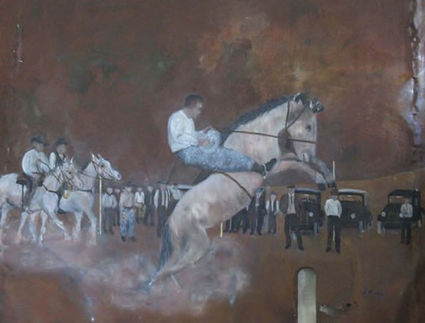
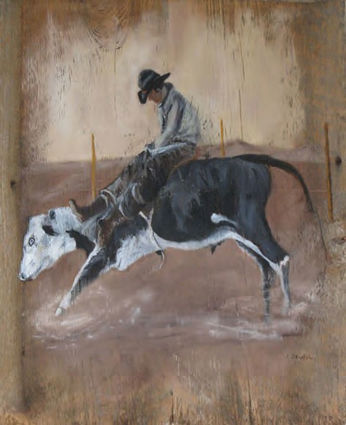
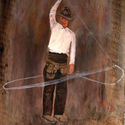
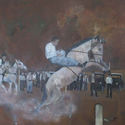
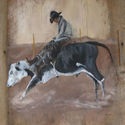





Reader Comments(0)